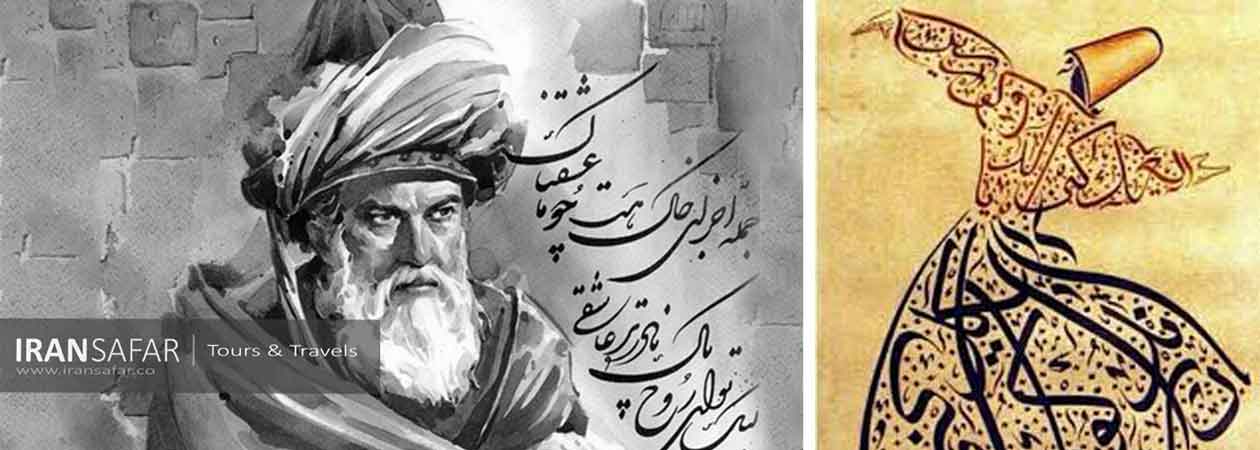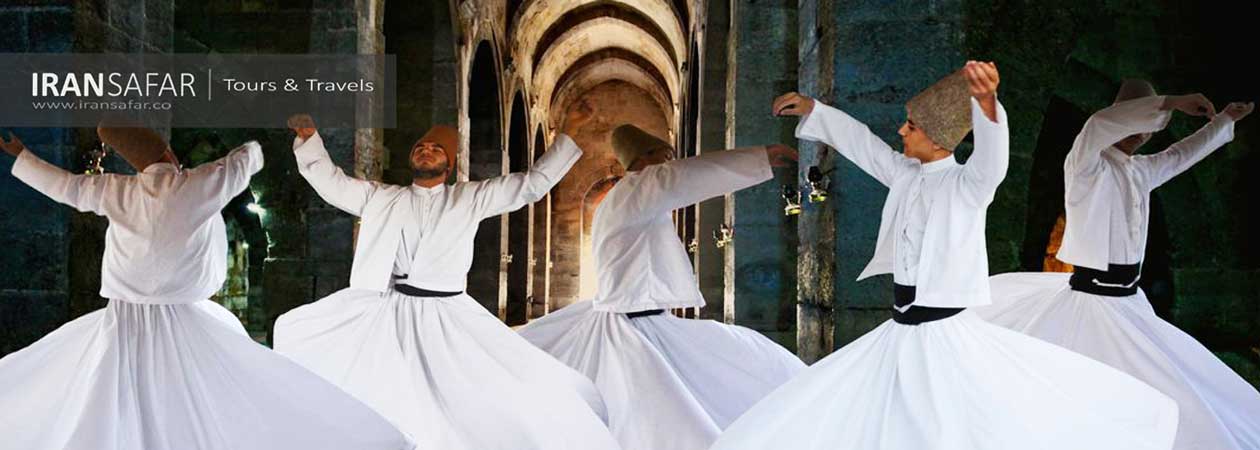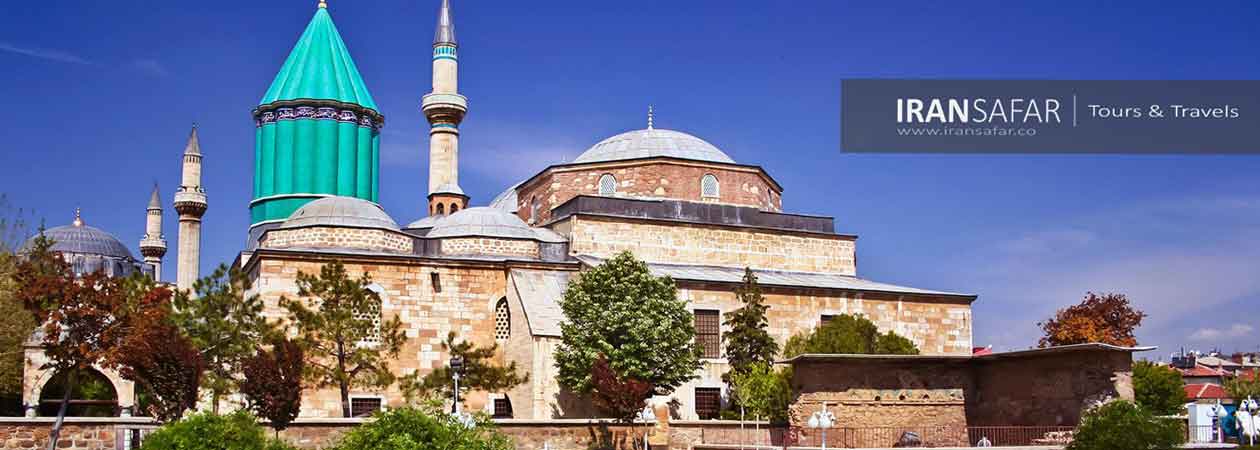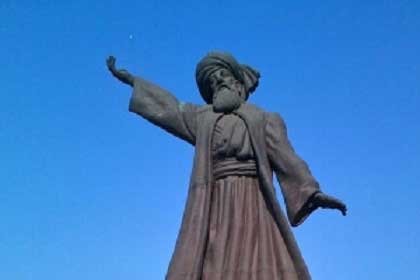The land of Iran has long been the cradle of mystical thought and enlightenment reflections. Thus, over the centuries, countless names have flourished in the field of mysticism and Sufism. One of these great figures is the famous Jalaluddin Mohammad Balkhi, who is known as Mowlana in Persia and as “Rumi” in West.
Jalāl al-Dīn Rūmī (1207 – 1273 CE)
The most famous Sufi mystic poet in the Persian language, Rūmī, in full Jalāl al-Dīn Rūmī, known in Persia as Jalāl ad-Dīn Muhammad Balkhī (also simply called Mowlana or Mowlavi – an honorific meaning “our master”) was born c. September 30, 1207, Balkh of Afghanistan on the eastern edge of the Persian Empire of that time—died December 17, 1273, Konya [in current Turkey]). Rumi is globally renowned for his lyrics and for his didactic epic Masnavi-e Maʿnavi (“Spiritual Couplets”), which widely influenced mystical thought and literature throughout the Muslim world. After his death, his followers were organized as the Mowlawiyeh order.

Rumi’s Biography
Rumi is widely celebrated for his mystical poetry, which continues to captivate readers and inspire spiritual seekers around the world. This article delves into the life and legacy of Rumi, shedding light on his journey of self-discovery, his poetic expressions of divine love, and the enduring impact of his teachings.
Early Life and Education
Rumi was born in 1207 in Balkh, a city located in present-day Afghanistan. His father, Bahāʾ al-Dīn Walad, was a renowned mystical theologian, author, scholar and theologian. Because of his Sufi beliefs led to a dispute with local government or maybe the threat of the approaching Mongols, Bahaʾ al-Din and his family left their home town of Balkh about 1218. It’s said that in Nīshāpūr, Iran, young Rumi met Aṭṭār, a very famous mystical poet, who blessed Jalal al-Din and this meeting opened his eyes to find his way of life. From a young age, Rumi received a comprehensive education encompassing theology, Islamic jurisprudence, and literature. His exposure to a wide range of disciplines laid the foundation for his later spiritual and poetic explorations.
Journey to Konya
After a pilgrimage to Mecca and long journeys, the family reached Anatolia (present Turkey – called Rūm at that time) a peaceful and prospers region under the rule of the Turkish Seljuk Empire. After a few years, Rumi’s father was invited to stay at the capital, Konya, in 1228. Here, Bahāʾ al-Dīn Walad started to teach at one of the numerous theological schools; after his death in 1231 he was succeeded in this capacity by his son.
Spiritual Awakening
Rumi had many fans and admirers. According to historians, when his assembly was held, the crowd was so large that the surrounding alleys were full of his lovers, but his life changed when such a great and popular leader met with Shams Tabrizi – A wandering Mystic. Rumi’s life took a transformative turn when he encountered Shams, who had a profound impact on Rumi, serving as his spiritual guide and mentor. Their intense companionship sparked a deep spiritual awakening within Rumi, leading him to embark on a lifelong journey of self-discovery and divine love. He spent much of his life traveling extensively throughout the Middle East.
Shams Tabrizi
The decisive moment in Rumi’s life occurred in 1244, when in the streets of Konya he met the wandering dervish, Shams al-Din Tabrizi, whom he may have first encountered in Syria. Shams was a traveling Sufi dervish who was different from all those around Rumi. He disrupted all of Rumi’s understanding of truth. From the perspective of Shams, The existence of all creatures is guided by love … it is love that guides everything in existence. Love is the foundation of the Universe … of creation; God was in Love, so he created…
Shams, however, breaks the religious dogmatism in Rumi, introducing him to a different world of cognition. Shams’ influence on Rumi’s life is such that he turned from a zealot and a religious scholar into a heartbroken lover.
Shams cannot be connected with any of the traditional mystical fraternities; his overwhelming personality, however, revealed to Jalal al-Din the mysteries of divine majesty and beauty.
Rumi abandoned the preaching courses and passionate mystical poetry began to flourish in his mind, he was seen Sema dancing and singing in the streets like lunatics. No one knew what Shams Tabrizi taught to Rumi and what he learned that change him that way, but it is clear that Shams was mistakenly thought by Rumi’s followers to be an ignorant scholar, though his writings were the best evidence of his extensive knowledge in the fields such as literature, vocabulary, interpretation of the Quran and mysticism.
For months the two mystics lived closely together, and Rumi abandoned his pupils and family so that his followers started to mistreat Shams which led to enforce him to migrate to Syria in February 1246. Jalal al-Din was heartbroken, and his eldest son, Sulṭan Walad, eventually got mission to bring Shams back from Syria. The family, however, could not tolerate the close relation of Rumi with his beloved, and one night in 1247 Shams disappeared forever, probably murdered.
Rumi Books
Masnavi-e Ma’navi: Also spelled Mathnawi, or Mathnavi, is an extensive poem consisting of a series of six books of poetry that together amount to around 25,000 verses or 50,000 couplets. It is like a textbook on mysticism and the principles of Sufism, ethics, education and Rumi is best known for this book. The Masnavi, which shows all the different aspects of Sufism in the 13th century, often carries the reader away with loose associations of thought, so that one understands what subjects the master had in mind at a particular stage of his life. The work reflects the experience of divine love. Masnavi has been recited in dance and sema ceremonies since the beginning of its writing, and even during Rumi’s lifetime, a class called Masnavi singers emerged, who sang Masnavi in a pleasant voice.
Ghazaliyat: This part of Rumi’s works is called Ghazaliat or Koliyat or commonly known as Divan-e Shams (the poetries of Shams) because Rumi has inserted the pen name “Shams” at the end of most poems instead of his own – that signifies the complete identification of lover and beloved. Rumi’s sonnets in Divan-e Shams consists about 2500 poems.
Quatrains: Deep mystical and spiritual meanings and themes are found in Rumi’s collection of quatrains that are deeply connected to Rumi’s ideology and thoughts. Ruba’iat implies 1659 quatrains. This collection is not as popular as the other two works of Rumi, Ghazaliat and Masnavi.
Rumi’s Ideology
Belonging to the Hanafi School of Islamic law, Rumi was a Suni Muslim, but not an orthodox type. Since his ideology always urged unlimited tolerance and peace, in his poems there are lots of lyrics showing traces of his full respect to Shi’ite saints such as Imam Ali. Rumi looked with the same eye on Muslim, Jew and Christian alike, and his tolerant teachings have appealed to all sects and creeds.
Rumi’s use of Persian Poetry, in addition to some Turkish, has resulted in his being claimed variously for Turkish literature and Persian literature, a reflection of the strength of his influence in Iran and in Turkey. The influence of his writings in the Indian subcontinent is also substantial. By the end of the 20th century, his popularity had become a global phenomenon, and Rumi was hailed by Western scholars as the greatest mystical poet of all time. The popularity of his poetry has spread in the West because of its heart-felt themes of lover-beloved mysticism
Poetry as Divine Expression
Rumi’s poetry is a testament to his deep spiritual connection and his ability to articulate the ineffable aspects of divine love. His verses touch the hearts of readers across cultures and generations, inviting them to embark on their own inner journey of self-discovery and spiritual awakening. Rumi’s words act as a bridge between earthly existence and the realm of the transcendent, resonating with seekers of truth and lovers of beauty.
In his introduction to an English edition of Spiritual Verses, translator Alan Williams wrote: “Rumi is both a poet and a mystic, but he is a teacher first, trying to communicate what he knows to his audience. Like all good teachers, he trusts that ultimately, when the means to go any further fail him and his voice falls silent, his students will have learnt to understand on their own.”
Influence and Legacy
Rumi’s influence extends far beyond the boundaries of his time and place. His poetry has been translated into numerous languages, making it accessible to a global audience. Rumi’s timeless wisdom and profound insights continue to inspire poets, writers, and spiritual seekers from diverse backgrounds. His teachings emphasize love, tolerance, and the pursuit of inner truth, fostering a sense of unity among humanity.
 Whirling dervishes in Sema dance performance in Konya, Turkey
Whirling dervishes in Sema dance performance in Konya, Turkey
Also Read: Sufizm & Hafez
 Mevlana Museum: Historic mausoleum & Dervish museum, Konya, Turkey
Mevlana Museum: Historic mausoleum & Dervish museum, Konya, Turkey
How did Rumi die?
Rumi lived for a short while after completing the Masnavi. In December 1273, he fell ill; he predicted his own death and composed the well-known Ghazal, which begins with the verse:
Do not cast thy glance upon my golden face, for I have iron legs.
Rumi died on 17 December 1273 in Konya. It is said that Molana’s wife was crying beside his bed before he died, praying for him for four hundred years of life. But Rumi smiled: “We didn’t come to this mundane earth seeking to stay; we are imprisoned here, hoping to reach our beloved as soon as possible” He always remained a respected member of Konya society, and his company was sought by the leading officials as well as by Christian monks. His burial procession, according to one of Rūmī’s contemporaries, was attended by a vast crowd of people of many faiths and nationalities. His mausoleum, the Green Dome, is today a museum in Konya; it is still a place of pilgrimage, primarily for Turkish Muslims.His death was mourned by the diverse community of Konya, with local Christians and Jews joining the crowd that converged to bid farewell as his body was carried through the city.
The Relevance of Rumi Today
In today’s fast-paced and interconnected world, Rumi’s poetry holds immense relevance. His verses offer solace to those navigating the
complexities of modern life, providing a glimpse into the eternal truths that lie beyond the material realm. Rumi’s teachings encourage individuals to cultivate compassion, mindfulness, and a deeper understanding of themselves and others.
Konya, the city of Rumi
Konya, historically bielived to be ancient Iconium of Roman times, is located in central Turkey. Surrounded by a narrow fertile plain, the city lies at an altitude of 3,370 feet (1,027 metres) on the southwest edge of the central Anatolian Plateau. This major city is the seventh most populous city in Turkey with a metropolitan population of over 2.1 million With its orchards, gardens, and monuments, modern Konya attracts a growing tourist trade. Its association with the Dervishes makes it a place of pilgrimage for Muslims. Konya is one of Turkey’s oldest continuously inhabited cities once served as the capital of the Seljuk Turks from the 12th to the 13th centuries, it ranks as one of the great cultural centers of Turkey. During that period of cultural, political and religious growth, the mystic Mowlana Jalal Al-Din Mohammad Balkhi or Rumi, created a Sufi order known in the West as the Whirling Dervishes. The outstanding green-tiled mausoleum of Mowlana is Konya’s most famous building.
Rumi, Best-Selling Poet in the US
A poetry book named The Essential Rumi, translated by Coleman Barks, became the top-selling title in the US.
Coleman Bryan Barks (born 1937 in Chattanooga, Tennessee) is an American poet and translator and retired professor of English at the University of Georgia (1967–1977). Although he does not know Persian, he is known for rewriting Rumi’s poems based on other English translations.
Different translations of Rumi’s poetry by authors Coleman Barks, Reynold Nicholson, E. H. Whinfield and A. J. Arberry have long been printed and sold in the US, among which the commendable 22-volume translation of Barks that took him 33 years to complete have been significantly highlighted. The 1990 transcript has always been at the top of the book selling list, overtaking celebrated ancient British poets like William Shakespeare and William Blake.
As new translations come into print, and his work continues to resonate, Rumi’s influence will continue. His inspiring words remind people how poetry can be a sustaining part of everyday life.
Rumi Inspiring Quotes
Frequently Asked Questions About RUMI



RUMI is from today’s Afghanistan who traveled and settled in Konya, today’s Turkey. Rumi’s Mother Tongue was Turkic. I believe he was a type of Turkoman. person who wrote in Persian. Since Persian was only written language at that time. I am quite metaphysical. I conversed spiritually with Rumi in His Museum in Turkey in Turkish. He also speaks Turkish like a native not only Persian.
Thankyou so much for your information. I recently purchased a book on RUMI. Looking forward to a new way of thought & life ♡
Konya is absolutely amazing. The Mevlawi complex contains the tomb of Rumi, founder of the Mevlevi order of dervishes. The place is filled with treasures including old copies of the holy Quran. Fantastic walls and ceilings (unfortunately photography is not allowed inside). Smaller inside than it looks from outside. It is essential to have an audio guide because there are no explanatory signs in English.